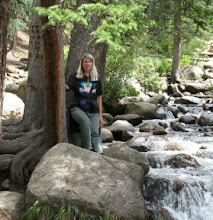 Longfellow says the Hawthorn buds "ope in the month of May." And he's right! Thorny as their name suggests, these foothills natives often grow in impenetrable thickets along streams and gullies. The dry fruits resemble rose hips, and, though usable in jams, are more tempting to birds and bears than to the rest of us. Note that the glossy leaves and innocent flowers develop simultaneously, making a striking white-on-green composition. Equally lovely, when the fruits mature, is their red-on-green effect against the leaves. Stop in later for fall color. In our area, Crategus erythropoda, Crategus macrantha (formerly C. occidentalis).
Longfellow says the Hawthorn buds "ope in the month of May." And he's right! Thorny as their name suggests, these foothills natives often grow in impenetrable thickets along streams and gullies. The dry fruits resemble rose hips, and, though usable in jams, are more tempting to birds and bears than to the rest of us. Note that the glossy leaves and innocent flowers develop simultaneously, making a striking white-on-green composition. Equally lovely, when the fruits mature, is their red-on-green effect against the leaves. Stop in later for fall color. In our area, Crategus erythropoda, Crategus macrantha (formerly C. occidentalis). A smaller shrub, often equally thorny, is the American Plum. As shown here, with leaves just expanding, the flowers are past prime. So when the flowers first open, branches are bare, making this an easy rose to identify long distance! The large fruits are much enjoyed by birds, bears, even coyotes. Prunus americana.
A smaller shrub, often equally thorny, is the American Plum. As shown here, with leaves just expanding, the flowers are past prime. So when the flowers first open, branches are bare, making this an easy rose to identify long distance! The large fruits are much enjoyed by birds, bears, even coyotes. Prunus americana. One final Rose for today, the Serviceberry. Equally tasty (probably more so to humans) and less thorny, these are also found in the rosy thickets of foothills canyons. Fruits, this time, look more like blueberries than anything else. Best distinction, I think, is the smooth, round leaves, jagged only on the outer edge, and an unusual smooth purplish bark. Amelanchier alnifolia.
One final Rose for today, the Serviceberry. Equally tasty (probably more so to humans) and less thorny, these are also found in the rosy thickets of foothills canyons. Fruits, this time, look more like blueberries than anything else. Best distinction, I think, is the smooth, round leaves, jagged only on the outer edge, and an unusual smooth purplish bark. Amelanchier alnifolia.More on native shrubs in the Rose Family.

1 comment:
This is great - thanks
I love these wild roses!
Post a Comment